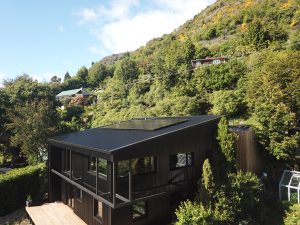Case Study: Moonlight Passive Home
The system
Panels:
14 x Hyundai 390w Black
Battery:
Tesla Powerwall 2 13.5kWh
Inverter:
Fronius Primo 5.0
The install
Compound approached us when building Moonlight. Their goal was to build an energy-efficient, high-performing home using passive home principles. So how does a solar install work for a passive home?
As we do with all installations, we modelled the home using building plans and took into account angle to the north, the pitch of the roof, local weather data, and any shading from nearby trees buildings and topography to create accurate data of how much electricity the solar system could produce.
We then matched this modeling with the expected energy demand of the home (provided by the client) to design a system that matched their energy needs. Because the build is so energy-efficient, our modeling showed the energy demand would be lower than a typical home in Queenstown. Therefore, we installed a slightly smaller system than we normally would for a home of this size.
A key challenge with this installation was working with a building envelope that is airtight (a feature of passive homes). This meant we needed to work with the builder and the manufacturer of Pro Clima (the building liner) to ensure any penetrations were suitable.
The system went live in the middle of winter, so how has it performed?
On a sunny day in winter (short days), the system was producing 10 kW, which meant solar could take care of energy needs during the day and still charge the battery.
Even in the Winter equinox, they were effectively off-grid for 19 hours of the day, relying on solar and stored energy in the Tesla Powerwall.
Taking advantage of their energy retailer’s free power hours coupled with Tesla’s time-based control has also significantly reduced the power bill. The Powerwall will charge directly from the grid during this period at zero cost.
During months with longer sunlight hours, data shows the home is effectively off-grid for 23 hours a day. There are only small peaks where power is drawn from the grid with a net cost of zero because solar exported to the grid balances out the energy drawn from the grid.
The results
Expected power production: 70% of the homes power demand, about 6-8000kwh per year.
Expected power bill savings: bills are expected to be 20% of what they would be without solar (increased by the free charging of the Powerwall).
Projected carbon footprint reduction: 835kg of CO2 per year – that’s the equivalent CO2 savings of driving from Queenstown to Auckland 4 times.
Keen to know more? Watch Compound’s YouTube series to hear Paul (Queenstown Solar Managing Director) talk about the install:
If you are keen to find out more about solar for passive homes, fill out the form below and one of our team will get in touch with you to see how we can help.